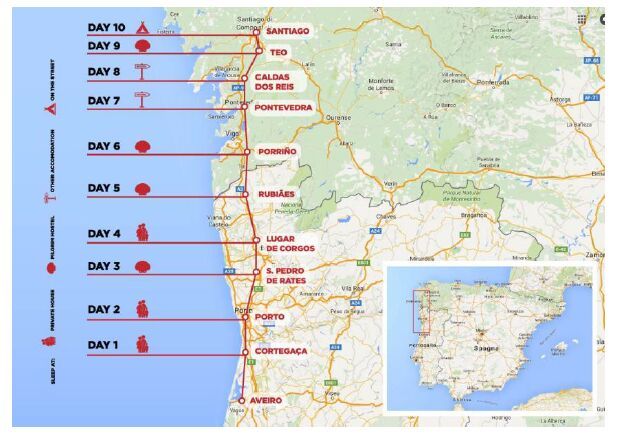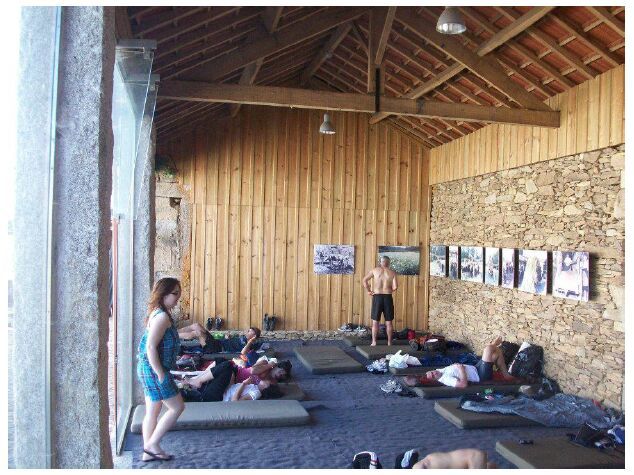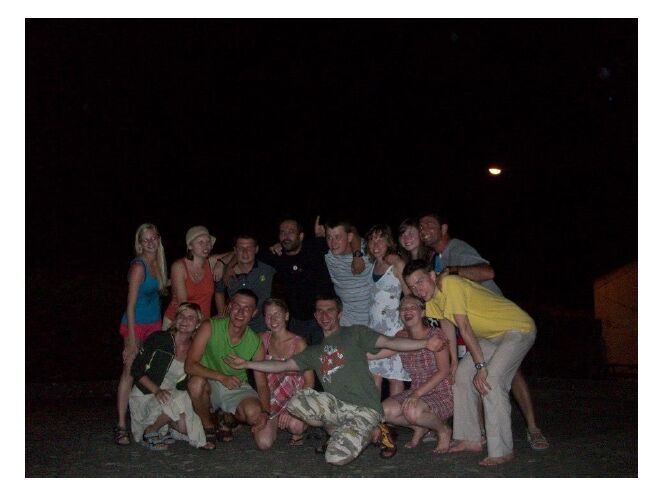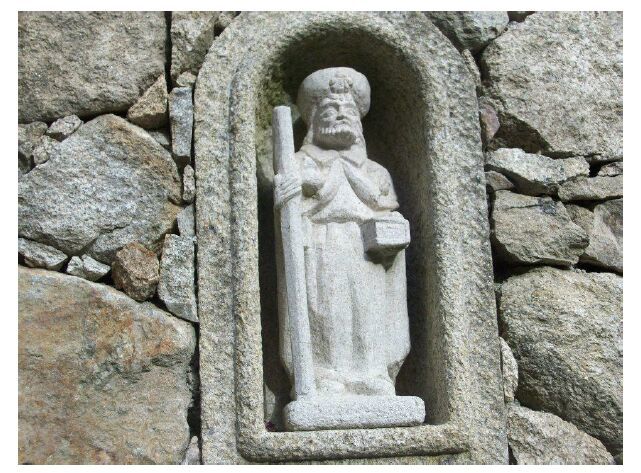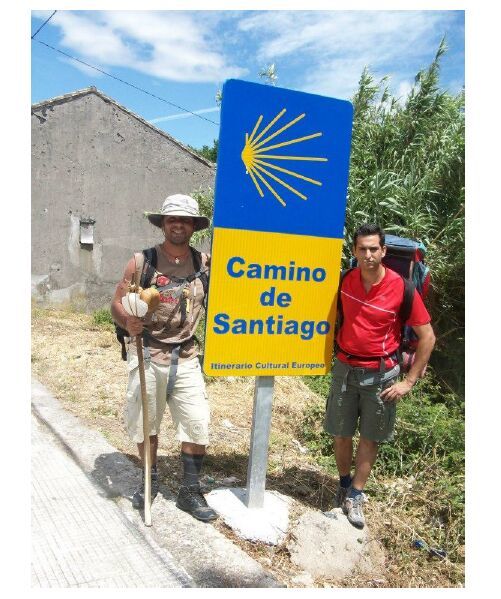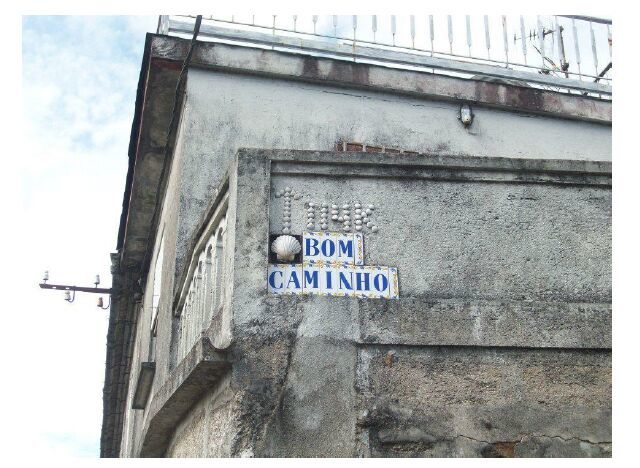1. Introduction
James, son of Zebedee, one of the Twelve Apostles of Jesus, is the central figure of one of the most popular pilgrimage we are about to discourse in this article. After his beheading in Jerusalem (44 d. C.) which made him become the first apostle to be martyred. James's remains were stolen by his disciples and carried to the coast of Galicia, Spain to be buried. The grave was later discovered in the year 830, after miraculous events, and the place of discovery was called Campus Stellae (Field of the Star) from which derives the name of Santiago de Compostela, today capital of Galicia. The king of Asturias and Galicia, Alfonso II the Chaste (789-842), ordered the construction of a temple where they discovered the grave. Since 893, Benedictine monks have lived and managed this holy place and the Peregrinatio ad limina Sancti Jacobi, the Way of St. James, began. At first, the pilgrims came just from Asturias and Galicia, then from all over Europe. Many consider this phenomenon a great contribution to the "construction" of modern Europe.
The Camino de Santiago thus became one of the three medieval Peregrinationes Maiores, together with the Holy Land and Rome. Several historical curiosities related with this experience exists. Its symbolism is fascinating and rich, and with some controversial aspects as well, such as the little-politically-correct iconography of Santiago Matamoros (Santiago, the slayer of Moors)! Anyway, the set of symbols contained in the experience of the pilgrimage to Santiago represent today part of a global collective imagination, also shown by the many novels written about this experience. The scallop shell of Santiago, the wide-brimmed hat, the stick and calabash of the pilgrims, the meaning of the way in itself are strong images related with the popular idea tied to the Camino de Santiago (and they are highly respected even today, as we have noted during the study presented in this article). The phenomenon of pilgrimage has continued over the centuries, passing thus from Spanish to European pilgrimage, and from European to global, nowadays. Indeed many pilgrims arrive in Europe by various means of transport for all over the world, to be able to walk through one of the traditional ways to Santiago, mainly the Camino Francés (passing through cities such as Pamplona, Logroňo, Burgos and Leon) or the Camino Aragonés (Jaca, Sanguesa, Enériz). Actually today, there is a large international route network, which also involve other countries besides France and Spain, like Italy and Portugal.
The phenomenon of religious pilgrimage has thus assumed other connotations and meanings, including that of the management of these circuits in order to boost the cultural and economic benefits they bring to the affected territories. In particular, during the last years the potentials of this occurrence is being increasingly enhanced and analysed within the context of tourism development and regional and transnational planning. The contact with nature, the enhancement of landscapes, the preference for the typical gastronomy, the emphasis towards the cultural elements, the creation of networks and the management of transnational tourism products (Section 1).
This "evolution" of the phenomenon, and in some extent, its "manipulation" how much has altered the essence of this experience and the profile of the pilgrims? What are the motivations, the needs and expectations of the latter, and their perception of the whole experience? Who is, for instance, the pilgrim of Santiago, today? Most travel by foot, some by bicycle, and a few choice to “imitate” the medieval pilgrims by using horses or even donkey. In addition to those undertaking a religious pilgrimage, many are hikers who walk the route for other reasons: travel, sport, or simply the challenge of weeks of walking in a foreign land. In addition, many consider the experience a spiritual adventure to remove themselves from the bustle of modern life. Many studies indeed already analysed these profiles from a tourism or even economic point of view, due to their impacts on the regions affected by the phenomenon.
The creation of knowledge about these aspects represents a key step in the process of creating a coherent, authentic and sustainable cultural tourism experience: the international routes of the Way to St. James. We thus felt the necessity of a more personal, qualitative approach to this matter. We have decided to meet in a direct and thorough way the “new pilgrims” and share this experience with them, by becoming one of them, a pilgrim of Santiago. A full immersion in the studied phenomenon, thus, an observer- pilgrim watching out for the overall perceptions about how the new trends affect the overall experience, in a pilgrimage between religion and tourism, authenticity and innovation, local development and intercultural dialogue.
This is our research question, to which we responded through a total immersion in the studied phenomenon (Section 2). The surprising conclusions (Section 3) open the way for new qualitative and quantitative studies on different aspects of such a special, global phenomenon that is the pilgrimage to the tomb of St. James, at Santiago de Compostela, Spain.
2. Religious tourism routes as a tool for sustainable development
Thematic Routs are nowadays increasingly included within the strategies of tourism development and territorial competitiveness. Raffestin [1] defined the tourist route, an experience of discovery and knowledge of the identity of places, its genres de vie, its landscapes, and its past, present, and future prospects. In addition, an itinerary includes a number of components proved and probable, as the spatial, temporal and economic management, as well as those characterized by a strong subjectivity. Planning a route is thus a complex, integrated decision-making process, also offering great opportunities to apply the process of communities integration within Tourism Planning described by Malek and Costa [2]. Resources and local traditions such as crafts, food, religious feasts, festivals, wines and/or other particular characteristics of a territory are a function of tourist attraction that can be considered “microregional”. A thematic route contains thus in itself all the particularities and uniqueness of a territory, and its aim is to represent them, becoming a particularly effective tool of regional promotion and tourism development.
Over the past decades technological development has contributed to the development of a methodology for designing itineraries adding to traditional application tools computer systems that are able to collect, organize and process information in an automated way. GIS (Geographical Information System) is among the most commonly used and developed tools, even if there are other simpler systems, such as computer packages identification of road routes, which have a lower cost and directly available online (e.g. Google Maps). It is possible to distinguish in mono and multi-thematic tourist routes, depending on the type, duration and capacity of matching needs of users.
Within this broad context, religious routes have become important tourism products worldwide, as well as a tool of regional promotion [3,4]. Religious tourism focuses on the visit of religious sites or destinations, in order to consolidate a particular faith, and development of identity that refers to spiritual or religious enlightenment. These places attract the attention of visitors, not only for religious reasons, but also in terms of history, architecture or artistic value [5]. However, it is a very complex phenomenon, as most religious monuments can attract visitors who may not have any religious affiliation, but could have interest in the religious monuments because of their architectural, aesthetic or historical attractiveness and value [6,7]. The demand for religious tourism requires, in addition to visiting holy places, walking along religious itineraries and experiencing ancient pilgrimage routes, even satisfying emotional and intellectual needs, in search of culture, authenticity and spirituality [8].The complexity and importance of this growing phenomenon attracts the attention of academics, tourism industry and policy makers.
In particular, our interest lies with the specific phenomenon of the combination of tourism and religious pilgrimage, which provides many opportunities of tourism development, rural areas enhancement and regional and transnational (in the case of international routes) management. The great potentialities of this merger, is attracting the attention of researchers and land managers not only in Europe, where there are many Christian pilgrimage routes, but also in Islamic countries [9,10,11]. If on the one hand, “Pilgrimage tourism”, one of the oldest forms of tourism, is often considered as marginal, on the other hand it is one of the most widespread forms of tourism [12].
Routes thus become a genuine tourism product, which must meet the requirements of the user. In this context, routes should provide information on sites of natural and cultural interest and, additionally, pictographic road signs are created using a common logo to guide travellers. It is thus important to highlight the potential role of religious routes within the process of place branding. The latter is indeed that is fundamental in the context of tourism and territorial promotion, as Rinaldi [13] has noticed. Small, regional routes are normally integrated into national and regional framework, and must have easy vehicular access and navigation, as well as the ability to cope with the numbers of vehicle and visitors using it [14]. Religious routes represent a powerful instrument for developing long-term relationships with customers by utilizing customer databases. In addition, religious routes may create new jobs and generate commercial investments. For instance, the presence of tourists in rural areas is an opportunity both for environmental and socioeconomic aspects. It is also useful in order to alleviate tourism pressure in the more crowded urban destinations.
In Italy, for instance, namely in the Marche region, where Loreto is a lasting traditional religious destination, rural tourism has increased its role in sustaining revenues of local communities in the inner rural areas. Nevertheless, more specific and deeper survey are necessary in order to understand the real opportunities of development and the role of local communities in designing sustainable development and in fostering the attractiveness of destinations located in non yet developed tourist areas. Rurality and tourism seems to be a positive binomial, anyhow necessitating a robust local entrepreneurial and social fabric to be effective. According to Di Iacovo [15], “the organization of vibrant and durable rural communities regards diverse elements linked to the organization of human and social capital, the organization of local culture and identity, access to services and to natural resources”. From this point of view, local communities have the opportunity to develop religious itinerary in rural areas in order to enforce their economic capacity and social cohesion.
On the other hand the religious tourism and in particular pilgrimages meet perfectly the new needs of the demand, nowadays: cultural tourism, linked to the ancient devotional itineraries, indeed generates behaviours shaped by the new needs of society, more and more eager to combine physical needs and personal well-being with the equilibrium and serenity of spirit. It also offers opportunities to meet different cultures, opportunities to socialize and build trustable relationships and empathy/sympathy with the hosting communities [3,4,16,17]. In this sense, one of our conviction and starting point for the present study, was also related to the perception of the Camino as a vehicle of intercultural dialogue, thus it would be recommendable to manage it according to the principle of the Paideia Approach to Cultural heritage Management [18].
Finally, it is not to forget the function and the cultural implications over the centuries of pilgrimages, especially at European level. The continuous passage of people from various parts of Europe and from very different traditions has allowed the various European cultures to meet and mingle, so that Goethe - talking about the pilgrimage to Santiago, our object of study - had already noticed that "the conscience of Europe was born on the way of the pilgrimage" [19]. The management of such a large and internationally shared common heritage is certainly complex, but the political and administrative solutions are not lacking. In this sense, according to Mariotti [20], the creation of cultural routes is one of the best ways to manage at local, interregional and- we can say—transnational and international level common cultural values and the cultural heritage which represents them.
3. Problematisation and Methodology
3.1. Santiago de Compostela and its Camino
Santiago de Compostela is a Spanish town in the autonomous community of Galicia, province of La Coruňa. Its fame is because for over a millennium, according to Christian tradition, the mortal remains of the St. James, apostle of Jesus, are kept in the city’s majestic cathedral. The latter thus represents the final destination of the Camino de Santiago (Way of St. James). Santiago became one of the three pilgrimage sites for Christians, together with Rome (reachable by crossing the Via Francigena) and Jerusalem (accessible by the sea from Brindisi, Italy) [19]. UNESCO has declared Santiago de Compostela and the famous pilgrimage World Heritage and the Council of Europe has recognized the importance of religious and cultural routes through Europe to rich Santiago de Compostela. Over the years, this religious phenomenon has been studied and analysed from many point of views, and the way was equipped with supporting infrastructure to pilgrims. This has attracted a number of peregrinos who decide to make the Camino de Santiago not necessarily for strictly religious reasons. Therefore, if today the St. James Way, like other route of pilgrims, is considered a vehicle of territorial sustainable development, as we have seen in the previous section, which are the modern pilgrim perception of the way, in terms of authenticity of the experience? In order to answer this question, we decided to embark on the Way to Santiago, and experience first-hand, as observers, this experience.
3.2. Methods and data collection
For the present study we have adopted a qualitative approach, coherently with the constructivist paradigm embraced, which emphasizes the understanding of the motivations underlying the behaviour of the agents involved in the phenomenon analysed. This approach was operationalized though a case study, as the most indicated to explain a complex phenomenon [21]. The case-study method has the potential to bring out various angles from which a particular topic can be discussed [22], and it represents an holistic analysis to obtain a deep understanding of a contemporary phenomenon in its real context, using multiple sources of evidence [23]. Particularly, it is valuable with regard to its ability to explain the complex relations in a multi-faceted sector such as tourism as shown by Beeton [23].
With regard to the data collection technics adopted, it was important considering the reflection of Corbetta [24], which distinguishes the hard data from the soft data: the former are characteristic of quantitative studies, while the latter are typical of the qualitative approach. We have also considered the discussion of Mason [25] about the qualitative data sources and methods, that is concern with the differences between the concept of generating data rather than collecting data, precisely because most qualitative perspectives would reject the idea that a researcher can be completely neutral collector of information about the social world. This author explains that we can perceive people as “data sources” in the sense that they are repositories of knowledge, evidence or whatever relevant for the research: observing this people, talking to them and collecting products that they had generated is the first step to create data through the implementations of our “data generation methods” [25].
Based on all these considerations, we designed our study, and our fieldwork has taken place in July 2010. A single researcher, Fabio Carbone, first author of the present work, has conducted the field research. On the other hand, the entire research group has conducted the literature review and data processing. For purely practical reasons, we have chosen the Portuguese way to Santiago, starting from Aveiro (Portugal) and following the itinerary shown in Table 1:
Table 1.Itinerary followed for the field research
|
Day No.
|
Starting point
|
Main places of transit
|
Place of arrival
|
Distance
|
Accommodation
|
| Day One
|
Aveiro
|
> Ovar >
|
Cortegaça
|
49 Km
|
Hosted in private house
|
| Day Two
|
Cortegaça
|
> Espinho> Aguda >
Miramar> Gaia>
|
Porto
|
29 Km
|
Hosted in private house
|
| Day Three
|
Porto
|
> Vilarinho >
|
S. Pedro de Rates
|
40 Km
|
Pilgrim hostel
|
| Day Four
|
S. Pedro de Rates
|
> > >
|
Vitorino do Piâes
(Lugar do Corgo)
|
45 Km
|
Hosted in private house
|
| Day Five
|
Vitorino do Piâes (Lugar do Corgo)
|
>Ponte de Lima>
|
Rubiães
|
40 Km
|
Hosted in pilgrim hostel
|
| Day Six
|
Rubiães
|
> Valença do Minho >
Tui (Spain) >
|
Porriňo
|
33 Km
|
Hosted in pilgrim hostel
|
| Day Seven
|
Porriňo
|
> > >
|
Pontevedra
|
42 Km
|
Other accommodation
|
| Day Eight
|
Pontevedra
|
> > >
|
Caldas de Reis
|
25 Km
|
Other accommodation
|
| Day Nine
|
Caldas de Reis
|
> > >
|
Texo
|
36 Km
|
Hosted in Pilgrim hostel
|
| Day Ten
|
Texo
|
> > >
|
Santiago de Compostela
|
14 Km
|
Sleeping rough/on the street
|
The map shows graphically the route, stops and places where overnight stays have occurred.
Looking at the information provided by the map, it is important to observe that no night has been spent in hotels. This decision has been previously taken for methodological reasons. Our goal was to ensure the experience more balanced and consistent as possible with the religious pilgrimage, which historically included the "vow of poverty", a choice shared by most pilgrims still today, even if not explicitly, and not necessarily for religious reasons. For instance, regardless of the underlying reasons for the pilgrimage, pilgrims chose to enjoy a more authentic experience, enhance the contact with nature and local population, and/or—for those who are looking for a more spiritual experience—a total, cathartic abandonment to the experience of the camino, far from any element of modernity.
Data required was gathered as follows:
Direct observation: Direct participant observation, Example like those of Atkinson [26], Gouldner [27] and Jorgensen [28]. In various phases of the study, a field journal and an observation grid were used. In this regard, it is important to highlight one of the decisions taken before the departure in terms of equipment. As the perception of authenticity in the context of the overall experience was one of the issues to be addressed, and although today many pilgrims use the modern stick (light, sturdy and telescopic, providing comfort in inhospitable situations), we opted to use the typical staff of the pilgrim of Compostela, tied with the calabash to fetch water and the shell (see Figure 5). We have also used a traditional wide-brimmed hat, another symbol of the Pilgrims of Santiago. This allowed us to record the reactions of other pilgrims and local communities to the sight of these typical and mystical symbols.
Non-structured Interviews: During the journey, 40 non-structured interviews were conducted, involving a probabilistic simple random sample. We chose to select representatives of three different groups: pilgrims motivated by the religious faith; pilgrims motivated by reasons different from religion; people involved in the overall experience (local communities, priests and monks, etc.). Informants were from three different continents (Asia, America, and Europe), the interviews were conducted in four different languages (Italian, Spanish, Portuguese, English). The interviews were recorded with the approval of those interviewed. The Annex contains more details on the respondents, in order to clearly characterise the studied sample-track.
Document analysis: We have analysed documents such as:
Monographic publications;
Print and digital Press Archive;
Institutional documents such as White Papers-defined by the Oxford Dictionary as “book of rules, standards or records, especially an official government report, bound in white” - and Grey Literature [29], including the reports of other pilgrims gathered from a selection of blogs and online forums.
4. Results and Discussion
The findings of the research have confirmed the importance of an alternative approach to the study of pilgrimages. Interviews with representatives of different groups of Pilgrims of Santiago provided a complete view about their perception of the overall experience. First of all it is confirmed that those who decided to make the pilgrimage to Santiago are seeking—albeit to varying degrees, according to the motivations and personal tastes - for a strong component of authenticity, adventure and willingly accepts the adversities, perceiving them also as manifestation of the authenticity of the overall experience. Authenticity is thus a key-element for the satisfaction of those who we have met along the pilgrimage to Santiago, regardless their original motivation (religion, leisure, sport, etc).
In this regard, one of the most important result is the one related to the observation of the relation between the infrastructures for the pilgrims, in particular the albergues, where pilgrims use to spend their nights, and the level of perception of authenticity. The quality and the typologies of these infrastructures, as well as their policy of management, is not homogeneous along the way. It was observed—and then confirmed by the pilgrims’ opinions collected through the interviews—that these differences indirectly produces among the pilgrims a different perception of the experience, that can be seen as “authentic” or “turistified”. In these regard, an important detail is that also the representatives of the group of pilgrims motivated by reasons different from religion agreed with this idea. We can thus affirm that not only the pilgrims motivated by faith, but also those who experience the pilgrimage for recreation, are looking for a deeply authentic experience.
We also have observed a certain naturalness with which most of the participants in the study associate not only tourism with religion, as motivation for the pilgrimage, but also fitness and religion or leisure and religion. This finding may have implications in the management of routes, promoting partnerships with local activities related to health and fitness. Paradoxically, among the pilgrims involved in the study, those most prone to diversified activities were precisely those motivated by religious reasons to pilgrimage. On the contrary, the pilgrims characterised by a more intellectual approach and motivation, preferred to optimize the time of reflection and contemplation that the pilgrimage grants.
Another interesting finding was that of the perception of the way of Santiago as a vehicle for intercultural dialogue. The many pilgrims who come together have a tendency to socialize with each other (especially in the albergues, Figure 2), and spend relaxed time together, often promoting authentic cultural and intellectual exchanges.
Interculturalism is a very strong feature
In this sense, one of the most relevant observations was registered at the albergue of São Pedro de Rates. The young people responsible for the hostel had organized a meeting for the pilgrims to taste typical products. After the first minutes, pilgrims spontaneously transformed this activity into a culinary contest among them, and every group from a different country start to cook - the way they could - their traditional dishes. Activities like this are vehicle of intercultural dialogue that could and should be stimulated, even promoted, and repeated daily at the albergues. This consideration links this work to previous studies on tourism as a vehicle for intercultural dialogue, such as that related with tourism and the “Paideia Approach to cultural heritage management” [30] and more recently the one on Tourism and Cultural Heritage Quality Management [31]. Implication of this observation could be the stimulus, for example at the hostel for pilgrims to such activities of cultural exchange.
Another very strong observation has been that linked to the symbolism. The authenticity of the experience perception is strongly linked to typical Santiago symbols (the shell, the stick, etc.). These elements are strongly associated with the pilgrimage, also from the inhabitants of the areas along which the route passes. In our field journal, there are various records in this regard. For instance, during the whole journey we used and kept well visible the traditional and distinctive symbols of the Santiago pilgrim (see Section 3.2 and Figure 5) so that we could thus observed some typical reactions of the local population when they saw us passing by. We registered several ways they manifested their respect towards those symbols: they used to supply us with fresh food, fruit and water, but some persons also stopped us asking to "bring their prayers to the Saint", and sometimes they gave us small papers with dedications to the Saint, requests or prayers. Still, the first night of travel, unknown people have offered us their own home to rest, just as a reaction of the view of the symbols we were carrying.
On the pilgrim side, the degrees of perceived authenticity related to the symbolism is different, according to the use of these symbols. For instance, if they appear in form of graffiti along the way (Figure 4) they create a positive reaction in pilgrims.
On the contrary, symbols used as “logos” for the territorial marketing, or to promote commercial products, could provide a decrease of the enthusiasm of the pilgrims with a negative effect on their overall experience perception. On the other hand, this particular use of the symbols of Santiago contribute to strengthen the sense of safety of pilgrims, because it increases the perception of the existence of a well-structured and organized route (Figure 5).
Finally, the local population shows a strong curiosity towards the pilgrims and their symbols. It is an important point that is not taking into account. The participation of the population represent an instrument to confer authenticity to the experience of the pilgrimage (Figure 6).
by local inhabitants on behalf of pilgrims
5. Conclusion
The choice of the topic used as pilot project is based on the conviction of the importance of Tourism and Pilgrimages within European cultural heritage in a time which require the enhancement of our identity as well as the promotion of the inter-cultural dialogue. According to our study, the authenticity is the first value that pilgrims expect from the overall experience of pilgrimage, today, regardless their original motivations (religious, spiritual, but also cultural and intellectual, leisure and even fitness).
In this sense, we have observed that the infrastructures created for the pilgrims play an important role in the perception of authenticity. On the one hand, it is necessary developing and implementing plans to improve infrastructure, carrying capacity management, security, technological innovation, but on the other hand, it is important that these facilities would be always balanced with the tradition and the primordial spirit of the pilgrimage.
Authenticity thus ensures a satisfying experience for the pilgrim, and at the same time it represents the essential element to guarantee socioeconomic sustainability to the hosting communities and it is a precondition to promote inter cultural dialogue. The latter issue was one of the major points of interest for our research. Especially in the current times in which racial and religious hatred are dangerously spreading, it appears more important than ever to use the travel activities, in particular the religious pilgrimage in the dimension they have nowadays, to promote universal respect for the spiritual values of humanity and the establishment of peace and prosperity in the world.
According to our observations, it is relatively easy to promote intercultural dialogue among pilgrims, namely in their main meeting points, the albergues. It would be appropriate to define thus policies of management for these places taking into account their function of “melting pot for global meetings and promotion of intercultural dialogue”.
Acknowledgements
Thanks to Alessandro Carbone and Silvia Danzi for the graphic contribution within the process of creation of the maps. To Padre Angelo (Cathedral of Aveiro, Portugal) for the insights on the more purely religious and spiritual aspects of the Camino. To João and Isabel for the athletic training done before the journey in order to improve the physical resistance and avoid injuries along the way. Thanks to Paulo, Pierre-Alain, and all the other pilgrims met during the walk, with whom this great experience was shared. They provided a priceless contribute towards a deep and complex understanding of the phenomenon. In particular, thanks to Patricia, Olga, Antonio, Andrea and Vincenzo. “Ultreia et Suseia!”. Buen Camino.
Annex 1.
|
Interviewed No.
|
Origin
|
Age
|
Gender
|
Means used along the way
|
Motivation
|
|
>20
|
>31
|
>40
|
>50
|
>60
|
| Interv. 1
|
Portugal
|
X
|
|
|
|
|
F
|
Walking
|
Religion
|
| Interv. 2
|
Spain
|
|
X
|
|
|
|
F
|
Walking
|
Leisure, sport
|
| Interv. 3
|
Spain
|
X
|
|
|
|
|
M
|
Walking
|
Leisure
|
| Interv. 4
|
Italy
|
X
|
|
|
|
|
M
|
Walking
|
Leisure
|
| Interv. 5
|
Italy
|
X
|
|
|
|
|
M
|
Walking
|
Leisure
|
| Interv. 6
|
Czech R.
|
X
|
|
|
|
|
M
|
Walking
|
Religion
|
| Interv. 7
|
Czech R.
|
X
|
|
|
|
|
F
|
Walking
|
Religion
|
| Interv. 8
|
Czech R.
|
X
|
|
|
|
|
F
|
Walking
|
Religion
|
| Interv. 9
|
Czech R.
|
|
X
|
|
|
|
M
|
Walking
|
Religion
|
| Interv. 10
|
France
|
|
X
|
|
|
|
M
|
Walking
|
Other
|
| Interv. 11
|
France
|
|
|
|
|
X
|
M
|
Walking
|
Religion, other
|
| Interv. 12
|
Spain
|
|
X
|
|
|
|
M
|
Walking
|
Leisure, Sport
|
| Interv. 13
|
Spain
|
|
X
|
|
|
|
M
|
Walking
|
Leisure, Sport
|
| Interv. 14
|
Holland
|
|
|
X
|
|
|
M
|
Walking
|
Religion
|
| Interv. 15
|
Estonia
|
|
|
|
X
|
|
M
|
Walking
|
Religion
|
| Interv. 16
|
Estonia
|
|
|
X
|
|
|
F
|
Walking
|
Religion
|
| Interv. 17
|
Portugal
|
|
|
|
|
X
|
F
|
Walking
|
Religion
|
| Interv. 18
|
Portugal
|
|
|
|
X
|
|
M
|
Walking
|
Religion, Sport
|
| Interv. 19
|
Portugal
|
|
|
|
X
|
|
F
|
Walking
|
Religion
|
| Interv. 20
|
S. Korea
|
|
|
|
|
X
|
M
|
Walking
|
Religion
|
| Interv. 21
|
S. Korea
|
|
|
|
|
X
|
F
|
Walking
|
Religion
|
| Interv. 22
|
Portugal
|
|
|
X
|
|
|
M
|
Bicycle
|
Leisure, sport
|
| Interv. 23
|
Portugal
|
|
|
X
|
|
|
F
|
Bicycle
|
Leisure, Sport
|
| Interv. 24
|
Portugal
|
|
|
|
|
|
|
Bus/walking
|
Religion, leisure
|
| Interv. 25
|
Portugal
|
|
|
|
X
|
|
|
Bus/walking
|
Religion, leisure
|
| Interv. 26
|
Portugal
|
|
|
|
X
|
|
|
Bus/walking
|
Religion, leisure
|
| Inter. 27
|
Portugal
|
|
|
|
|
X
|
|
Bus/walking
|
Religion, leisure
|
| Interv. 28
|
Portugal
|
|
|
|
X
|
|
|
Bus/walking
|
Religion, leisure
|
| Interv. 29
|
USA
|
|
X
|
|
|
|
|
Airpl., Walking
|
Leisure, other
|
| Interv. 30
|
USA
|
|
X
|
|
|
|
|
Airpl., Walking
|
Leisure, other
|
| Interv. 31
|
Spain
|
X
|
|
|
|
|
|
Walking
|
Leisure, other
|
| Interv. 32
|
Spain
|
X
|
|
|
|
|
|
Walking
|
Religion, leisure
|
| Interv.33
|
Spain
|
X
|
|
|
|
|
|
Walking
|
Religion, leisure
|
| Interv. 34
|
Spain
|
X
|
|
|
|
|
|
Walking
|
Religion, leisure
|
| Interv. 35
|
Spain
|
X
|
|
|
|
|
|
Walking
|
Religion, leisure
|
| Interv. 36
|
Portugal
|
|
|
|
|
|
|
Walking
|
Religion, leisure
|
| Interv. 37
|
Italy
|
|
X
|
|
|
|
|
Bicycle
|
Leisure, sport
|
| Interv. 38
|
Italy
|
|
|
X
|
|
|
|
Bicycle
|
Leisure, sport
|
| Interv. 39
|
Italy
|
|
X
|
|
|
|
|
Bicycle
|
Leisure, sport
|
| Interv. 40
|
Portugal
|
|
|
X
|
|
|
|
Walking
|
Religion
|









 DownLoad:
DownLoad: 